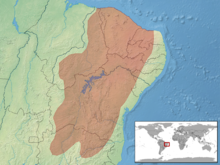Red and black lance viper
| Red and black lance viper | ||||||||||||
|---|---|---|---|---|---|---|---|---|---|---|---|---|

Red & Black Lance Viper ( Bothrops erythromelas ) |
||||||||||||
| Systematics | ||||||||||||
|
||||||||||||
| Scientific name | ||||||||||||
| Bothrops erythromelas | ||||||||||||
| Amaral , 1923 |
The red-black lance viper ( Bothrops erythromelas ), also known as the caatinga lance viper , is a species of viper from the subfamily of pit vipers and belongs to the genus of the American lance viper ( Bothrops ).
features
The red-black lance viper reaches a total length of rarely more than 40 to 50 cm (max. 85 cm). The head is angular, elongated, triangular in shape when viewed from above and clearly set off from the neck. The eye has a pupil that is vertically slit when exposed to light. There are dark, angular spots on the top of the head, a temple band and a U-shaped drawing between the head and neck. The body has a strong build and a dark gray to reddish brown basic color. There are dark brown, light-edged, rectangular spots along the middle of the back, as well as smaller red-brown spots in between. The ventral side is light and dotted with black. The venom apparatus consists of venom glands located on the side of the skull (specialized salivary glands ) and movable fangs located in the anterior upper jaw (solenoglyph tooth position).
Pholidosis
The pholidosis (scaling) shows the following characteristics:
- 7 to 8 upper lip shields ( supralabials ),
- two rows of small scales between the eye and the shields of the upper lip,
- 5 to 6 scales over the head, between the upper eye shields,
- 19 to 21 rows of elongated and keeled trunk scales ( Scuta dorsalia ),
- 144 to 158 abdominal shields ( scuta ventralia ),
- 32 to 42 under tail shields ( Scuta subcaudalia ) and
- 1 undivided anal shield ( scutum anale ).
Systematics
On the basis of molecular biological studies, among other things , Fenwick et al. (2009) and Wallach et al. (2014) proposed a split of the genus Bothrops . The red-black lance viper would be transferred to the genus Bothropoides under the name Bothropoides erythromelas . There are no subspecies of the red and black lance viper.
distribution
The distribution area within Brazil includes areas in Alagoas , Bahia , Ceará , Maranhão , Minas Gerais , Paraíba , Pernambuco , Piauí , Rio Grande do Norte and Sergipe . The populated biotopes are characterized by sandy or rocky areas with dry forests, scrubland, succulents and relatively open landscapes. In particular, habitats within the Caatinga should be mentioned. The climate is semi-arid .
Way of life
The red-black lance viper leads a largely ground-dwelling, partly climbing and nocturnal way of life. Wood, roots, stones or plants (e.g. terrestrial bromeliads ) can serve as hiding places . Often times, when disturbed, the head is hidden under the loops of the snake's body. The species is considered to be extremely aggressive when provoked and defends itself through poison bites. As a warning sign, the tip of the tail is moved vibrating, so that a rattling noise occurs when it comes into contact with fallen leaves. The front body can be thrown forward so that the range is great in the event of a bite. The range of prey primarily includes rodents and lizards . The propagation is done by ovoviviparity , so egg-viviparous.
Snake venom
A poison bite releases around 40 mg of poisonous secretion .
ingredients
The toxin mixture of the red and black lance viper contains, among other things, fibrinogenases as pharmacologically active components . It may also contain cytotoxins , hemorrhagins ( blood vessel-damaging metalloproteases ) and myotoxins . Bradykinin-potentiating peptide 13a, a peptide , intervenes in the renin-angiotensin-aldosterone system by blocking the angiotensin-converting enzyme . Consequently, in sufficient concentration, it has antihypertensive effects on the human organism. Acidic phospholipase A2 BE-I-PLA2, a phospholipase A2 enzyme, acts as a potent inhibitor of platelet aggregation .
toxicology
Few clinical reports are available. Local swelling , blistering , necrosis , coagulopathy and bleeding can not be ruled out as significant symptoms of poisoning after a venomous bite by the red-black lance viper. Various antivenins , such as 'Polyvalent Antivenom' (Instituto Clodomiro Picado, Costa Rica) or 'Soro antibotropico-laquetico' (Instituto Butantan, Brazil), are available for therapy.
According to Trutnau (1998), the red-black lance viper, together with the island lance viper ( Bothrops insularis ), is said to have one of the most potent poisons among the lance viper.
Danger
The IUCN lists the red and black lance viper as a 'least concern' (not endangered). This is justified by a large distribution area, large populations in the habitat and a relatively high tolerance with regard to the choice of habitat.
Individual evidence
- ↑ a b c d University of Adelaide, Clinical Toxinology Resources: Bothrops erythromelas (accessed July 6, 2018)
- ↑ a b Bothrops erythromelas in The Reptile Database (accessed July 2, 2018)
- ↑ UniProt: Bradykinin-potentiating peptide 13a (accessed July 6, 2018)
- ↑ UniProt Acidic phospholipase A2 BE-I-PLA2 (accessed on July 6, 2018)
- ↑ IUCN Red List: Bothrops erythromelas (accessed on July 6, 2018)
literature
- Ludwig Trutnau: Snakes in the Terrarium Vol. 2: Poisonous snakes . Verlag Ulmer, Stuttgart 1998, ISBN 3-800-1705-23 .
